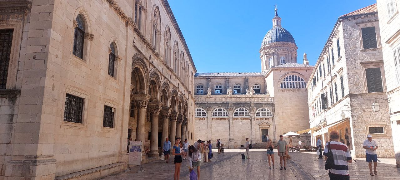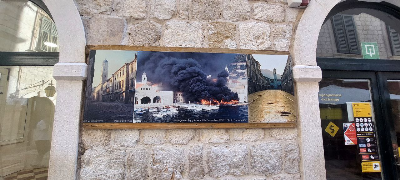
©
Дубровник — одне з найдавніших і найвідоміших міст Хорватії, розташоване на узбережжі Адріатичного моря. Засноване у VII столітті переселенцями з римського міста Епідаурум (нині Цавтат), воно історично було відоме під назвою Рагуза. У Середньовіччі Дубровник набув статусу незалежної республіки, що проіснувала з 1358 до 1808 року. Рагузька республіка вирізнялася високим рівнем морської торгівлі, дипломатії та правової системи. Місто стало осередком культури, освіти й архітектури: ще у 1416 році тут скасували рабство — одним із перших у Європі. Потужні міські мури, які оточують Старе місто, залишаються одними з найкраще збережених у Європі. У XIX столітті Дубровник перейшов під контроль Австрійської імперії, а після Другої світової війни став частиною Югославії. Під час хорватської війни за незалежність (1991–1992) місто зазнало значних пошкоджень. Під час шестимісячної осади, з жовтня 1991 по травень 1992 року, історичний центр отримав 650 артилерійських ударів. За офіційними даними, було пошкоджено 56% усіх будівель: понад 11 400 споруд постраждали, 886 з них — зруйновано повністю. Вартість реставраційних робіт оцінили у 35 мільйонів доларів США. ЮНЕСКО разом з Інститутом охорони пам’яток Дубровника провели масштабну інвентаризацію ушкоджень, координували реставрацію, а також надали понад 500 тисяч доларів на термінові роботи, відновлення дахів та збереження фресок. Сьогодні Дубровник — об’єкт Світової спадщини ЮНЕСКО (від 1979 року) і один із найпопулярніших туристичних напрямків у Європі. Його називають «перлиною Адріатики» — завдяки кришталево чистим водам, середземноморському клімату та мальовничим кам’янистим пляжам.
Станом на 2024 рік у місті мешкає близько 42 500 осіб. Щороку Дубровник приймає понад 4 мільйони туристичних ночівель. Водночас міська влада стикається з викликами: зниженням кількості постійного населення, активною еміграцією, високими цінами на житло та перевантаженням історичного центру. У відповідь влада запроваджує обмеження на короткострокову оренду, контролює туристичний трафік і розробляє політику сталого розвитку.
Dubrovnik’s Enduring Legacy: Surviving War and the Pressures of Tourism
Dubrovnik is one of Croatia’s oldest and most iconic cities, located on the Adriatic coast. Founded in the 7th century by settlers from the Roman city of Epidaurum (modern-day Cavtat), it was historically known as Ragusa. During the Middle Ages, Dubrovnik rose to prominence as an independent republic — the Republic of Ragusa — which lasted from 1358 to 1808. It was renowned for its advanced maritime trade, diplomacy, and legal system. The city flourished as a hub of culture, education and architecture, and in 1416 became one of the first places in Europe to abolish slavery. Its imposing stone walls, encircling the Old Town, remain among the best-preserved fortifications on the continent. In the 19th century, Dubrovnik came under the rule of the Austro-Hungarian Empire, and later became part of Yugoslavia following World War II. During Croatia’s War of Independence (1991–1992), the city suffered extensive damage. Over the course of a six-month siege, from October 1991 to May 1992, the historic centre was hit by 650 artillery shells. Official reports indicate that 56% of buildings were damaged — more than 11,400 structures were affected, 886 of them completely destroyed. The cost of restoration was estimated at 35 million USD. UNESCO, in cooperation with the Institute for the Protection of Cultural Monuments of Dubrovnik, conducted a comprehensive damage survey, coordinated the recovery effort, and provided over 500,000 USD in emergency funding — including for roof repairs and the conservation of frescoes. Today, Dubrovnik is a UNESCO World Heritage Site (listed in 1979) and remains one of Europe’s most sought-after tourist destinations. Often referred to as the “Pearl of the Adriatic,” the city is admired for its crystal-clear waters, Mediterranean climate and dramatic coastal scenery.
As of 2024, Dubrovnik is home to approximately 42,500 residents. The city welcomes over 4 million overnight tourist stays annually. Yet with this popularity come challenges: a declining permanent population, rising emigration, soaring housing costs and overcrowding in the historic centre. In response, the local authorities have introduced restrictions on short-term rentals, implemented tourist flow controls, and are actively pursuing sustainable development strategies.

©
1287